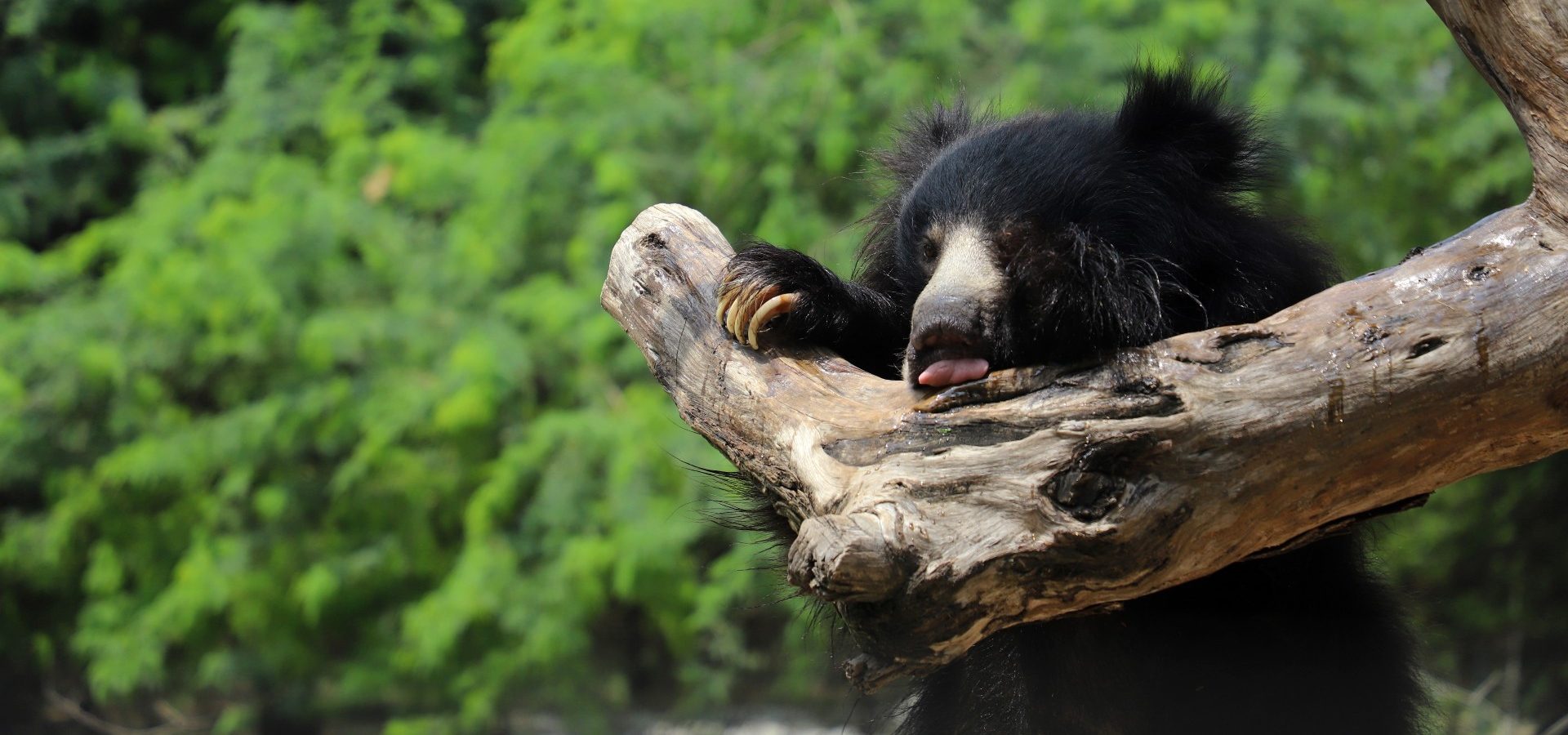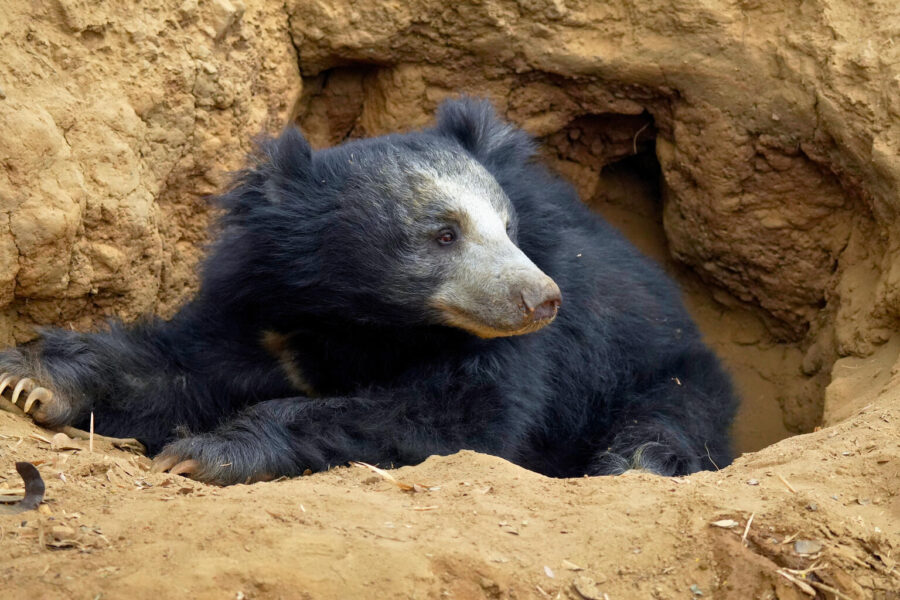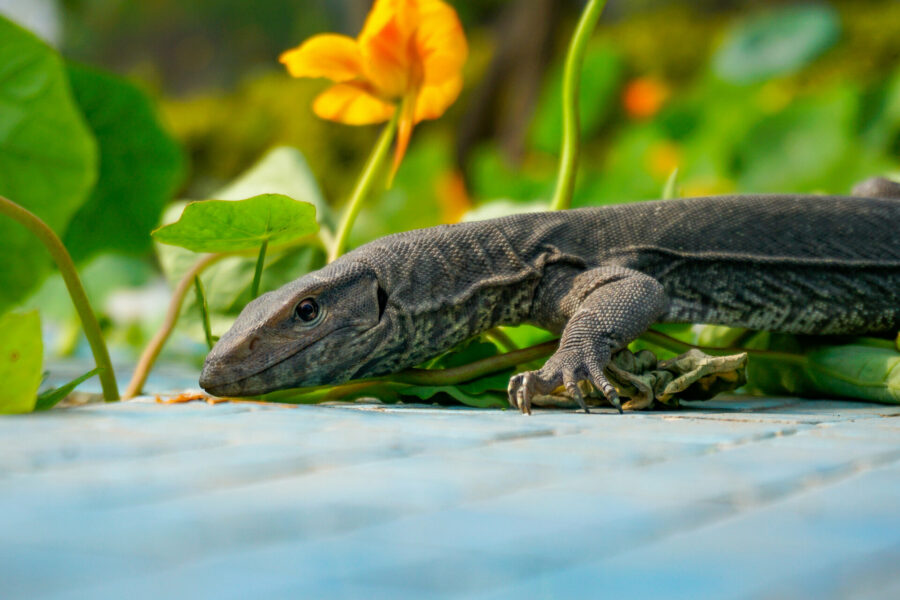After a long drive through heat and dust, my colleagues from Wildlife SOS and I approached the gates of the Sur Sarovar Bird Sanctuary in Agra. Navigating through the dense foliage of the sanctuary, with the picturesque Keetham lake by our side, we drove at an unhurried pace as one should within a sanctuary where animals often cross the road. On our way, we saw a few visitors birdwatching and some others enjoying the view of the lake.
![Rescued sloth bears sleeping in their hammock enrichments at ABRF. [Photo (c) Wildlife SOS/Shresatha Pachori]](https://wildlifesos.org/wp-content/uploads/2022/11/220112_ABRF_Shresatha_Sloth-Bear_Ganesha_Winter-Management_Hammock-3.jpg)
We had reached the facility that was home to Sloth bears rescued from the ‘Dancing’ bear tradition, as well as from wildlife traffickers and human-wildlife conflict situations. The ‘Dancing’ bear tradition referred to a 400-year-old practice wherein a community known as the Kalandars depended on these animals for sustenance. Sloth bear cubs were poached from the wild, and their muzzles were painfully pierced without any anaesthesia. A rope was then passed through these pierced holes, which when tugged, would force the bear to stand up on its hind legs in agony. This movement by the bear was interpreted as “dancing” by tourists, who would watch it for sheer amusement. Though this practice can be traced back to the Mughal era, it transitioned into cheap, roadside entertainment soon after the fall of the empire.
![Sloth bear cub poached for the 'dancing' bear tradition. [Photo (c) Wildlife SOS/Shresatha Pachori]](https://wildlifesos.org/wp-content/uploads/2022/11/Dancing_bear_project_kalandar.jpg)
Most of these bears suffered from ailments like tuberculosis, dental injuries, malnutrition, along with tick and flea infestation. With high mortality rates and no access to healthcare, they lived their lives confined by a small rope. The condition of the Kalandar community was no better, with a whole family or even an entire village depending on the income from a single bear for their livelihood. Literacy rates were negligible and access to healthcare was extremely expensive for a community that was so marginalised. When Wildlife SOS began rescuing Sloth bears, our team also worked towards providing alternative livelihoods to the Kalandar community. The rescued Sloth bears were given a safe haven at the Agra Bear Rescue Facility, the largest Sloth bear rescue centre in the world.
![Dental surgeries on sloth bears. [Photo (c) Wildlife SOS/Lenu Kannan]](https://wildlifesos.org/wp-content/uploads/2022/11/BBRC_Lenu_SlothBear_Odum_Dental-Procedure4.jpg)
The winding and narrow dirt roads that lead towards ABRF are lined with enclosures on both sides. There stands a watch tower overlooking it all, from where volunteers could see the rescued bears and observe their lifestyle. At first glance, many of the enclosures would look empty, but on taking a careful look, you can distinguish the camouflaged Sloth bears from their surroundings. Sometimes they would be sleeping under some bushes, or laying in a pit that they dug with their lengthy claws, and occasionally, you could even spot one that was hidden atop tree branches.
Aside from the Sloth bears that reside in these enclosures, a whole ecosystem of animals exists here — the most common ones being the Spotted deer, Rhesus macaques and various species of birds. While walking within the facility, one would often be accompanied by a couple of Spotted deer just a few feet away!
![Spotted deer, often seen within the Sur Sarovar Wildlife Sanctuary. [Photo (c) Wildlife SOS/Mradul Pathak]](https://wildlifesos.org/wp-content/uploads/2022/11/Mradul_Chital.jpg)
As I made my way towards the medical unit, the head veterinarian was already present in his office, taking notes and maintaining records of the bears after having observed them closely, and from the feedback given by their caregivers. The rest of the facility was also abuzz, with staff photographers capturing the best of the Sloth bears, each caregiver chopping fruits for the bears and staff members organising items for volunteers to browse through at the gift shop.
![The gift shop at ABRF. [Photo (c) Wildlife SOS/Mradul Pathak]](https://wildlifesos.org/wp-content/uploads/2022/11/CE2A9294.jpg)
I stepped into the store and perused through the collection of beautiful hand-printed stoles, shawls and handicraft items as well Wildlife SOS’ exclusive merchandise. Aarti, who manages the gift shop and merchandise, spoke to me about how a selection of the hand-made products were by the women of the Kalandar community who were provided with alternative livelihoods and skill training to start their own micro-enterprises.
![Some decorative items made by Kalandar women. [Photo (c) Wildlife SOS/Mradul Pathak]](https://wildlifesos.org/wp-content/uploads/2022/11/CE2A9351.jpg)
I then ventured out to meet the veterinary officer to learn more about the health condition of the bears. The first name that immediately popped into my mind was that of Ron, named after the protagonist’s best friend from the Harry Potter franchise. The veterinary officer mentioned that all bears including Ron were doing well, and that Ron spent a lot of time running around in his field and digging up mud.
![Sloth bear Ron in his field at ABRF. [Photo (c) Wildlife SOS/Shresatha Pachori]](https://wildlifesos.org/wp-content/uploads/2022/11/221029_ABRF_Shresatha_Sloth-Bear_Ron_General-3.jpg)
Perhaps he noticed the eager look on my face because I was soon led by the veterinarian to Ron’s field. His enclosure consisted of a tunnel, a pool and some log enrichments. As the afternoon sun was still quite bright, Ron had crept into his den to enjoy the pleasant gust of wind coming through the cooler inside it. When we reached the den, we dipped our feet into the disinfectant liquid that lines the border of all the enclosures. This makes sure that no foreign substances make their way into the bear’s den to cause any diseases. Upon noticing our presence, Ron came out of his den and looked at us with curiosity through the gate. As soon as he saw the familiar face of the veterinary officer, he was at ease.
The veterinary officer mentioned that the bears are regularly given target training which simplifies medical procedures. It is not an easy feat to treat wild animals — animals like leopards are required to be given anaesthesia for medical procedures. However, with bears and elephants, target training and positive reinforcement allows them to trust their doctors and caregivers and so, they present their limbs or other body parts for minor medical treatments. To demonstrate how useful target training is, the veterinary officer asked Ron to show his forelimbs and chest for a small examination, which he readily did so.
A caregiver who stood nearby offered to escort me to one of the biggest Sloth bears at ABRF, whose name is Kabilan. Kabilan is an extremely active bear, who climbs his way up to the tallest branches despite his massive size. Upon seeing me and his caregiver approach the enclosure, Kabilan stood up on his hind limbs to assess whether I posed any threat to him or not. But when his caregiver assured the large bear in a calm but firm voice, Kabilan went back to his field and resumed his play.
![Kabilan - one of the largest Sloth bears at ABRF. [Photo (c) Wildlife SOS/Shresatha Pachori]](https://wildlifesos.org/wp-content/uploads/2022/11/221029_ABRF_Shresatha_Sloth-Bear_Kabilan_Wooden-Log-3.jpg)
The sound of a food cart moving outside caught my attention, and Kabilan’s caregiver informed me that it was feeding time. All bear caregivers rolled the food carts to the many enclosures spread across ABRF. I followed Arthur’s caregiver who was in the process of neatly cutting up watermelons, coconuts, and papayas for the bears to eat. He mentioned that Arthur was quick to eat his meals and that he had a preference for watermelons, followed by papayas and finally, apples. Predictably, Arthur ate his food in this exact order, eliciting a chuckle from his caregiver. Feeding time is an important part of the daily routine as it allows the caregiver to observe the bear’s behaviour and gauge any changes such as a decreased appetite, sluggishness or puking. If the caregiver notices something worrying, he immediately makes a record of it along with the details of the meal, and reports it to the veterinary officer so that they can intervene medically.
![Arthur playing with one of his enrichments that was made by his caregiver. [Photo (c) Wildlife SOS/Shresatha Pachori]](https://wildlifesos.org/wp-content/uploads/2022/11/221029_ABRF_MRADUL_BEAR_ARTHUR-3.jpg)
The caregiver’s suggestions about the bear’s diet, enrichments and target training are instrumental in maintaining the longevity and mental well-being of the bear and smooth functioning of a rescue centre. Their inputs are very valuable for the veterinary officer, as they understand bear behaviour in a way no one else does.
![The bear caregivers feed the bears and monitor their health. [Photo (c) Wildlife SOS/Shresatha Pachori]](https://wildlifesos.org/wp-content/uploads/2022/11/211210_ABRF-EXTENSION_Shresatha_Bear-Keeper_Murari-Lal_Porridge-Feeding-8.jpg)
After seeing the efforts of the veterinary and bear care team at Wildlife SOS, my team and I had a better understanding of the efforts that it took to pull the curtain on the ‘dancing’ bear practice. Though it is not a common sight to see Sloth bears being tugged by a rope along the streets of India anymore, it doesn’t mean that the task has come to an end. Our work is an ongoing effort to ensure that the rehabilitated bears get the best medical care and a peaceful environment to recuperate from their traumatic past.
Something as cruel as the impact of the tourism industry doesn’t fade from the minds of these bears so easily. While some like Ron may have escaped suffering at an infant stage, many others remain impacted by the mental stress after years of abuse.
You can support us by making a kind = donation that can help us provide the best medical care, food and a sustainable shelter to our rescued and rehabilitated bears. To ensure that the Kalandar community doesn’t ever have to depend on ‘dancing’ bears, you can sponsor the education of a Kalandar child so that they can move towards alternative livelihoods.





